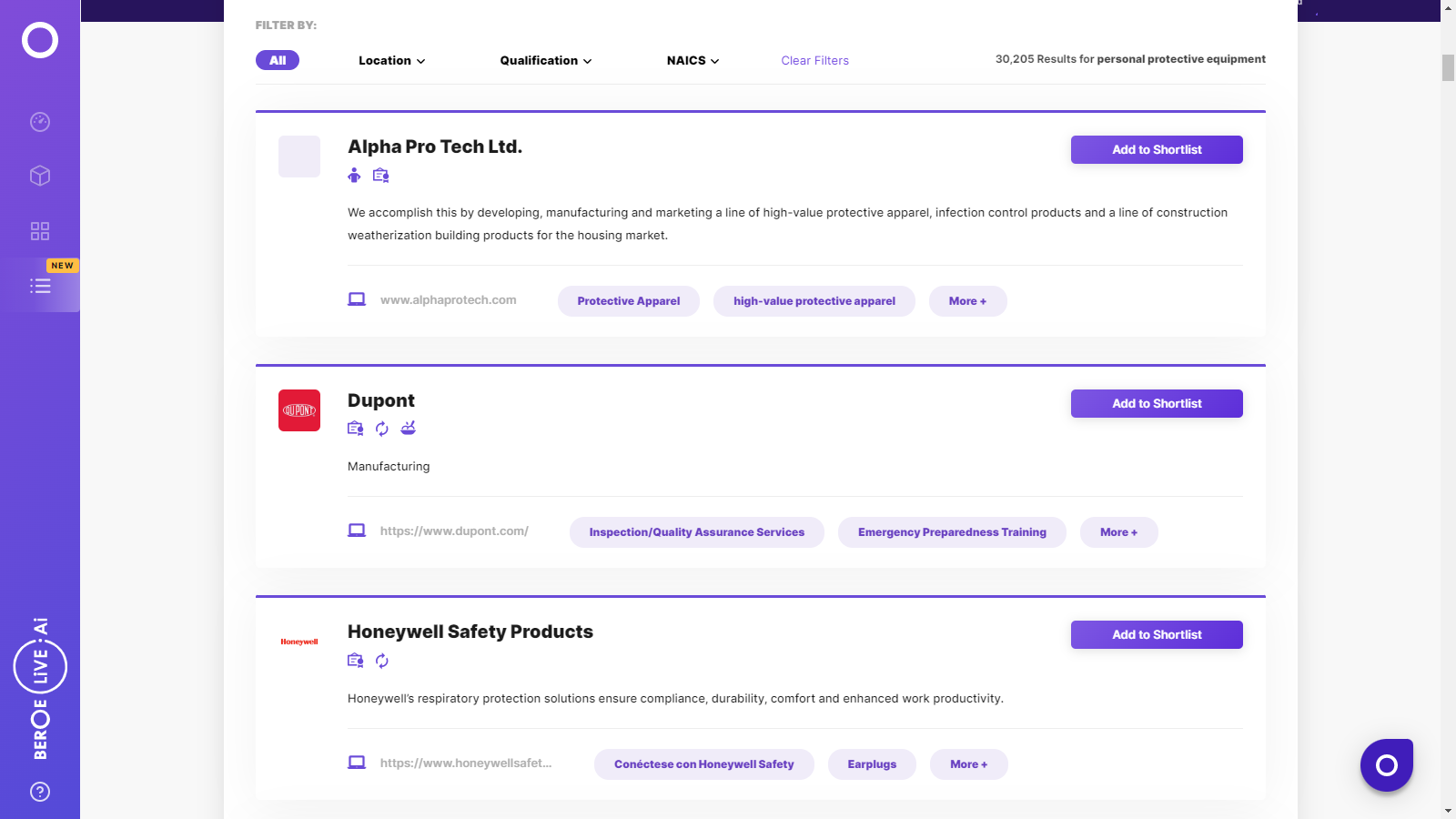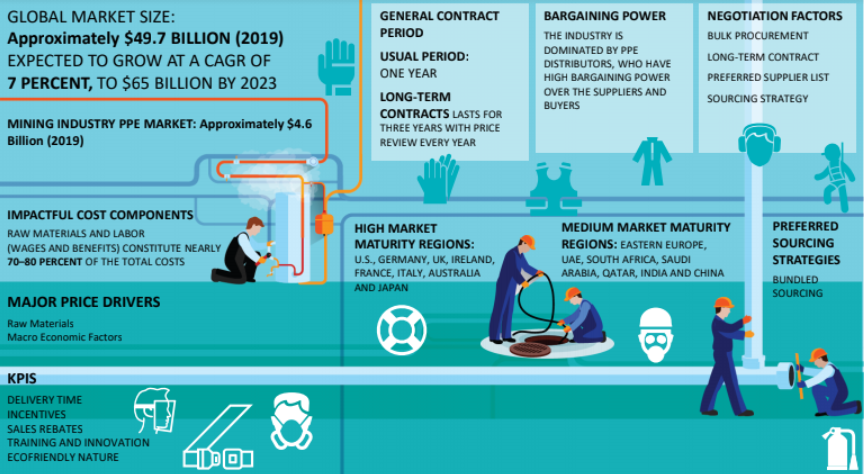CATEGORY
Personal Protective Equipment
Personal protective equipment (PPE) are safety equipment worn to minimize human exposure to hazards that cause serious workplace injuries and illnesses.
Beroe LiVE.Ai™
AI-powered self-service platform for all your sourcing decision needs across 1,200+ categories like Personal Protective Equipment.
Market Data, Sourcing & Supplier Intelligence, and Price & Cost Benchmarking.
Schedule a DemoPersonal Protective Equipment Market Monitoring Dashboard
Understand the correlation between costs, margins, and prices impacting your category on a real time basis on Beroe LiVE.Ai™
Schedule a DemoPersonal Protective Equipment Industry Benchmarks
Savings Achieved
(in %)
The average annual savings achieved in Personal Protective Equipment category is 9.80%
Payment Terms
(in days)
The industry average payment terms in Personal Protective Equipment category for the current quarter is 67.5 days
Compare your category performance against peers and industry benchmarks across 20+ parameters on Beroe LiVE.Ai™
Category Strategy and Flexibility
Engagement Model
Supply Assurance
Sourcing Process
Supplier Type
Pricing Model
Contract Length
SLAs/KPIs
Lead Time
Supplier Diversity
Targeted Savings
Risk Mitigation
Financial Risk
Sanctions
AMEs
Geopolitical Risk
Cost Optimization
Price per Unit Competitiveness
Specification Leanness
Minimum Order Quality
Payment Terms
Inventory Control
The World’s first Digital Market Analyst
Abi, the AI-powered digital assistant brings together data, insights, and intelligence for faster answers to sourcing questions
Abi is now supercharged with GPT4 AI engine. Enjoy the ease of ChatGPT, now on Abi
Personal Protective Equipment Suppliers

Find the right-fit personal protective equipment supplier for your specific business needs and filter by location, industry, category, revenue, certifications, and more on Beroe LiVE.Ai™.
Schedule a Demo


Use the Personal Protective Equipment market, supplier and price information for category strategy creation and Quaterly Business Reviews (QRBs)
Schedule a DemoPersonal Protective Equipment market frequently asked questions
As per Beroe's PPE market analysis, the protective clothing market size is expected to grow to $65 billion by 2023.
Beroe's PPE overview report identifies the high market maturity regions to be US, Germany, UK, Ireland, France, Italy, Australia, and Spain and the medium market maturity regions to be Eastern Europe, UAE, South Africa, Saudi Arabia, Qatar, India, and China.
The latest trends in the industrial protective clothing market are that the PPE market for the mining sector is dynamically shifting from mature to emerging markets due to change in customer preferences as well as technological advancements.
As per Beroe's PPE market trends report, the PPE clothing market is expected to grow at a CAGR of 7% by 2023.
The key drivers for the industrial protective clothing market are rise in demand from core industrial sectors, such as oil and gas, construction, chemicals, healthcare, metal, and automotive. The major price drivers will be raw materials and macroeconomic factors.
Personal Protective Equipment market report transcript
Personal Protective Equipment Market Size and Forecast
-
The global PPE market was valued at $63 billion in 2022 and is expected to grow at a CAGR of around 7.5–8 percent and reach $85 billion by the end of 2026
-
Trends observed among the global distributors are: Offering new supply solutions, online platform to sell products, marketing products through partnership, and creating customer loyalty programs
-
Industrialization, foreign investments, government regulations, and increasing awareness among workers would boost the demand for PPE
-
Wearable and wireless technology would be on rise and the products clubbed with fashion, comfort, and quality would be emphasized by end-users

Global Personal Protective Equipment (PPE) Market Maturity
-
The global PPE market was valued at $63 billion in 2022 and is expected to grow at a CAGR of around 7–8 percent during 2022–2026
-
The global PPE industry has a highly fragmented supply market. Europe is the largest PPE demand market, followed by North America, APAC, the Middle East and Africa (MEA) and South America, respectively
Global Demand and End-user Segmentation
-
The global PPE industry spend is likely to be driven by the rise in demand of core industrial sectors such as oil and gas, construction, chemicals, healthcare, metal manufacturing, and automotive
-
Protective apparel and gloves would be the major spend categories amongst PPE, accounting for about 60 percent of the overall value
Market Trend and its Implication
-
The PPE market for mining industry is shifting from matured regions to emerging countries with changing preference from customers in terms of safety clubbed with fashion and involvement of technology in products.
Market Innovation : Personal Protective Equipment
Wearable technology and wireless technology are among the major trends to be observed in PPE industry to reduce risk and accidents at workplace
PPE suppliers would shift to partnering suppliers/service providers equipped with best technology
-
Integration of bluetooth technology with wireless technology for advancement in safety data management by sending faster messages when integrated with other PPE linked to software on incidents and potential hazardous situations.
-
Wearable technology for Radio Frequency (RF) identification and biometrics are in rise in safety market for monitoring the harms within limits.
-
Incorporating FitBit device provides body temperature, environmental temperature, heart rate, and activity level, which can be linked to wearable PPE to save worker life during a sudden change in body temperature or heart rate.
-
Wearable technology to track and monitor employees to keep them safe.
-
Using digital technology to develop high-tech products that are capable of augmented reality, sensors, cameras, transparent visor to display for real-time instructions.
Global PPE Drivers and Constraints
In terms of end user industry for PPE Manufacturing, Construction, Oil & Gas, Mining industry are important markets due to high level of occupational hazards
Drivers
-
Industrialization in emerging economies like China, India, Africa, Central and eastern Europe, LATAM will drive the growth of PPE
-
Improved regulations, such as laws on health and safety (occupational safety) in the work-place, and employee safety programs by various governments have increased the awareness of PPE products, which in turn increases the demand for PPE
-
Increasing demand for masks, face shields, gloves, googles and safety wear due to surge in COVID cases will drive demand for PPE
Constraints
-
Increasing use of green energy sources and biofuels due to environmental concerns related to green house gas emissions
-
Fluctuating raw material prices
-
The other major constraints of the PPE industry are the quality and regulation aspects for these products (which vary according to regions), which force manufacturers to adhere to required specifications. These aspects generally affect the growth of the industry
-
The slowdown in major end-use sectors like chemical and mining is expected to reduce the demand for the industry, especially with protective apparels and head protection equipment
Why You Should Buy This Report
- SWOT analysis of major players in the global MRO PPE category such as DuPont, Ansell, MSA safety, etc.
- It gives product profiles of key regional suppliers in the personal protective equipment industry
- The report details the global and hybrid engagement models, negotiation strategies and key performance index in MRO PPE procurement.
- The report gives the cost structure breakup and pricing analysis in the ppe industry.
- It shows the different market innovations and supplier trends in the global personal protective equipment market
Interesting Reads:
Discover the world of market intelligence and how it can elevate your business strategies.
Learn more about how market intelligence can enable informed decision-making, help identify growth opportunities, manage risks, and shape your business's strategic direction.
Get Ahead with AI-Enabled Market Insights Schedule a Demo Now
